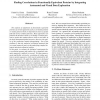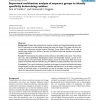1065 search results - page 134 / 213 » Predicting Peroxisomal Proteins |
RECOMB
2003
Springer
14 years 8 months ago
2003
Springer
We describe a novel method for detecting the domain structure of a protein from sequence information alone. The method is based on analyzing multiple sequence alignments that are ...
BIBE
2006
IEEE
14 years 2 months ago
2006
IEEE
The analysis of alignments of functionally equivalent proteins can reveal regularities such as correlated positions or residue patterns which are important to ensure a specific f...
EVOW
2004
Springer
13 years 12 months ago
2004
Springer
A number of bioinformatics tools use regular expression (RE) matching to locate protein or DNA sequence motifs that have been discovered by researchers in the laboratory. For exam...
IPPS
2006
IEEE
14 years 2 months ago
2006
IEEE
—Homology modeling requires an accurate alignment between a query sequence and its homologs with known three-dimensional (3D) information. Current structural modeling techniques ...
BMCBI
2007
13 years 8 months ago
2007
Background: Proteins that evolve from a common ancestor can change functionality over time, and it is important to be able identify residues that cause this change. In this paper ...


